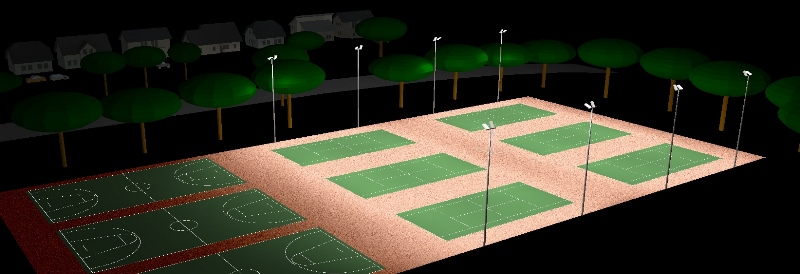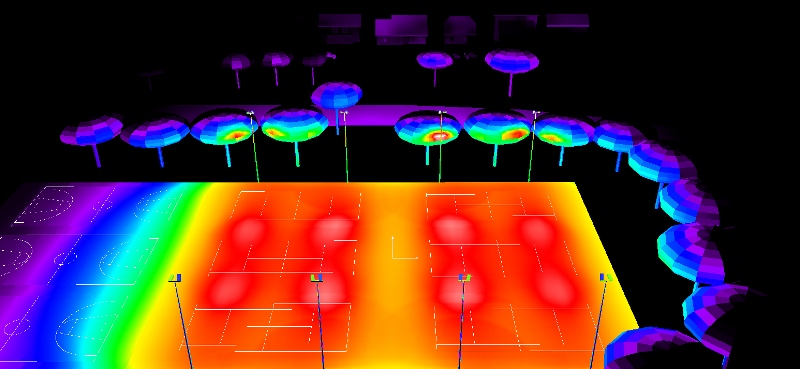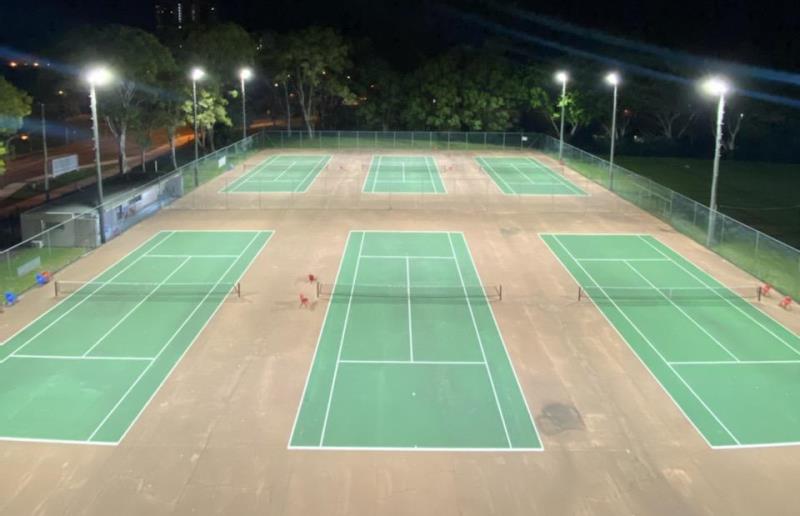 Loading... Please wait...
Loading... Please wait...- About Us
- LED Flood Lights
-
LED Lighting Projects
- Tennis Court LED Lighting Projects & Upgrades
- Netball Court LED Lighting - Case Studies & Projects
- Sporting Oval & Sports Field LED Lighting - Projects & Examples
- Lawn Bowls LED Lighting Projects & Upgrades
- General Area and Security LED Lighting - Projects & Applications
- Factory and Warehouse LED Lighting Projects & Applications
- Industrial LED Lighting Applications and Projects
- Help & Information
- Blog
- Contact Us
- Home
- LED Lighting Projects
- Tennis Court LED Lighting Projects & Upgrades
- Tennis Court Light Upgrade - Club Competition Level & Obtrusive Lighting Case Study
Tennis Court Light Upgrade - Club Competition Level & Obtrusive Lighting Case Study
Tennis Court Lighting Design Brief - Tennis Australia (Qld) for Palm Beach Currumbin Senior High School

In this tennis court lighting project we were approached by Tennis Australia (Qld) to find an economical solution to upgrade the unbalanced existing metal halide tennis court lights at Palm Beach Currumbin SHS with a brighter and more uniform and balanced LED tennis court lighting solution. The primary factors of consideration were price, followed by light levels, uniformities, and obtrusive lighting. The customer also wanted only 2 lights to be installed per pole. A summary of the required tennis court lighting specifications are as follows:
The target minimum maintained average lighting was specified at Club Competition Level 350 lux or better for the principal playing areas (PPA) for each court.
Target U1 uniformity (minimum/average) for the PPA of each court needed to be 0.75 or better (standard is > 0.6)
Target U2 uniformity (minimum/maximum) for the PPA of each court needed to be 0.50 or better (standard is > 0.4)
Target maximum glare rating was 50 and the lighting design must also comply with the Australian Standard for Obtrusive Lighting.
Tennis Court Light Design Solution
Pro Sport Tennis Court Lights. Using 16 of our 800W Pro Sports LED Flood Lights (LITE-EL-FL-800W) we were able to find the most optimal solution in terms of target lux levels, uniformity and price.
Tennis Court Light - External Driver Option. This customer also wanted the option to have the LED drivers mounted externally approximately 12m away from the light in a meter/switch style box. We were able to provide tennis court lights with an external driver solution, in addition to using reliable anaconda conduit with screw in gland/grommet fixings to protect and prevent wear and tear on the cables.
In addition, our Pro Series Sports LED Flood Lights use Mean Well ELG C or HLG C LED drivers which facilitate a DC output voltage of approximately 307V and 700mA. This is unlike many other competing or similar LED Sports Flood Lights which utilise DC output voltages in the vacinity of 50V DC. The 307V DC output is crucial as with the lower ~50V DC there is considerable voltage drop of 5% or greater depending on the length of the cable run. In the case of the Pro Sports LED Flood Lights with high 307V DC output voltage there is negligible voltage drop of < 1% ensuring the predicted level of tennis court lighting simulation results and cable runs of up to 40m or greater using 2 x 5 core 1.5 mm2 cable, which in turn keeps costs down and simplifies the wiring and installation of the external drivers. This makes our Pro Sports LED Flood Lights very suitable for high mast and stadium applications where the LED drivers are often mounted externally at a distance of 40m or greater from the LED flood Light. Note both Mean Well ELG and HLG Series Drivers have the regulatory compliance mark (RCM) and are compliant with Australian Standards AS/NZS 61347.1:2002.
415V Three Phase Tennis Court Lights. Many metal halide lights tennis court lights or flood lights due to their high power requirements are often wired into a 3 phase 415V AC supply. We can offer the use of the optional 415V Mean Well HVG Drivers generally for mining and industry applications, but it is not recommended due to the additional cost. In addition, the electrician has the option of connecting the normal 240V single phase tennis court light to one of the phases. He just needs to balance the phases (evenly connect the lights over the three phases) for improved power factor.
Examples of Venues where the Pro Sport LED Flood Lights have been installed. Some of the applications where our Pro Series Sport LED Flood lights have been used include Jindera Tennis Club NSW, Newstead Tennis & Squash Centre Tas, Indooroopilly Qld Residential Tennis Court, Norske Skog Paper Mill NSW Area Lighting, Mount Gambier Netball Courts, Illawarra Tennis Club Rockdale NSW (current), L&H and MM Electrical (various projects), and BB Malt WA Area lighting. Some of our other Sports LED Flood lights have been used at Somerton Park Tennis Club, Glen Forrest Bowling Club WA, Castrol Guildford West NSW, Cambridge Gulf Ltd Port Wyndham NT, Port Melbourne Vic (current), McGuigan BMW NSW. Please browse our LED Lighting Projects Section for more information.
Tennis Court Lighting Simulation Results - LITE-EL-FL-800W
Average Lux Level and Uniformity measured @ 1m. A light loss factor of 0.88 was used in the calculation of the results. The lighting simulation results for the LITE-EL-NED tennis court flood lights exceeds the Australian Standards for Club Competition Tennis Court Lighting.
Table 1: Lighting simulation results for the 800W Pro Sport LED Flood lights. Note that the Court Total Area (TA) corresponds to an area 34.77 x 17.1m consistent with Club Tennis Dimensions. Principal Playing Area (PPA) corresponds to the court only. TA has been provided for courts 1-3 and 4-6 combined due to the close proximity, but measurements are similar if TA is calculated for each individual court.
|
Court # |
Average Horizontal Illuminance @ 1m |
Min |
Max |
U1 Uniformity Min/Avg |
U2 Uniformity Min/Max |
|
Court 1 PPA |
364 |
321 |
473 |
0.88 |
0.68 |
|
Court 2 PPA |
367 |
335 |
413 |
0.91 |
0.81 |
|
Court 3 PPA |
365 |
322 |
472 |
0.88 |
0.68 |
|
Court 4 PPA |
364 |
321 |
472 |
0.88 |
0.68 |
|
Court 5 PPA |
367 |
335 |
414 |
0.91 |
0.81 |
|
Court 6 PPA |
365 |
322 |
473 |
0.88 |
0.68 |
|
Average |
365 |
326 |
453 |
0.89 |
0.72 |
|
|
|
|
|
|
|
|
Court 1-3 TA |
339 |
205 |
470 |
0.6 |
0.44 |
|
Court 3-6 TA |
339 |
205 |
470 |
0.61 |
0.44 |
Tennis Court Lighting Glare Rating – Target < 50 measured @ 1.5m.
Court 1, 21 observer points, range 33 to 40, average = 36.7
Court 2, 21 observer points, range 39 to 45, average = 40.9
Due to the symmetry of the lighting design courts 3 to 6 will have corresponding near identical glare ratings.
Tennis Court Obtrusive Lighting Predictions

This tennis court lighting design complies with the pre-curfew recommended maximum values for spill light and glare for residential areas, in accordance with AS 4282 "Control of the Obtrusive Effects of Outdoor Lighting", as described in the following sections.
The tennis court obtrusive lighting effects for this site are peculiar to Sarawak Avenue where houses face the tennis courts as shown in the above image. There is also a considerable amount of foliage in the form of large trees between the houses and the tennis courts. The tree canopies are in line with the houses and the flood lights obscuring their view from most of the houses and screening out light spill and light glare.
The primary cause of glare in this lighting project is the narrow beam flood lights which point at an angle of ~60° across towards the centre courts and to some extent out towards the houses. Whereas other four medium beam flood lights point down towards the edge courts at an angle of 30° from horizontal so create little light spill.
Tennis Court Light Glare.
Glare is not only important for the tennis players so they are not blinded by the lights necessitating a Glare Rating < 50, but it is also important for neighbouring houses and traffic and the general public, in addition to tennis court spectators, so they too are not blinded or distracted by tennis court flood lights which in some specifications can generate too much glare.
Light glare is different to tennis court light spill in that where light spill in the distance can be very little the glare in contrast can be very high and appear like a large bright distracting spot in the distance, a bit like a very bright star or full moon. To combat this problem there are certain specifications as follows but we can also install tennis court or flood light glare shields to block out the perceived light spot in the distance. For certain tennis court lighting configurations we also have the option to use our asymmetric beam tennis court lights which you can read about in our other projects and case studies. These asymmetric tennis court lights by pointing downwards essentially eliminate glare in the distance but could not be used in this tennis court lighting application due to the long distances involved from the tennis court light poles, which were also high at 15m.
According to Australian Standards for Obstrusive Lighting AS 4282 Level 2 glare control is utilised where the lighting installation requires the use of non-cut-off luminaires to achieve the required lighting levels, e.g. sports field or competition tennis court flood lighting. The maximum intensity values in these conditions are much higher. For small areas less than 25 metres across the maximum luminous intensity is 25,000cd. For medium size areas 25 metres to 75 metres across the maximum luminous intensity is 50,000cd and for large areas greater than 75 metres across the maximum luminous intensity is 100,000cd.
The total tennis court area is approximately 73m x 54 m so in this project the 50,000cd applies per luminaire.
From the houses oon Sarawak Avenue, viewing of the flood lights creates an apex angle of approximately 113° with the narrow beam flood lights angled at 60°, and an apex angle of approximately 145° with the medium beam flood lights angled at 30°. This equates to a maximum luminous flux of 140,763 lm for the narrow beam flood lights and 219,690 lm for the medium beam flood lights.
Therefore, the 800W narrow beam flood lights at 126,331 lm and the medium beam 800W flood lights at 129,200 lm used in the lighting simulation comply with Level 2 glare control for this size sports field.
Light Spill
AS 4282 applies to lighting installations operating from dusk to an 11.00pm curfew. The first factor is concerned with spill or stray light where spill light illuminance (lux) is measured or calculated in a vertical plane facing the luminaires of concern. The recommended maximum illuminance values for residential areas with either light or dark surrounds is 10 lux. Residential areas are considered to be in light surrounds where they abut major roads and to be dark surround where they abut local roads.
In the absence of any screening foliage, the amount of light spill measured at a height of 1.7m at curb side on on Sarawak Avenue across a distance of 4m to 76m is < 10 lux and therefore complies with pre-curfew hours. At the house frontages on Sarawak Avenue the maximum spill measurement is 8.45 lux at a height of 1.7m.
However, in reality when we include the effects of the foliage the light spill decreases to well below 10 lux at the curb side of on Sarawak Avenue. Conveniently the two inner narrow beam flood lights point slightly inwards towards the trees further reducing the light spill and glare.
For the 800W Pro Sport LED Flood Lights the vertical illumination perpendicular to the tennis courts @ 1m and 1.7m at each distance across a width of 4m to 76m along the houses on on Sarawak Avenue is shown in Table 3 below including the effects of foliage. The average vertical lux measurements curb side on the Northern Road are in the range of 1.1 to 3.7 lux looking out across at the tennis courts. This is well within pre-curfew limits for obtrusive lighting.
As there are mainly 2 and 3 story houses on the Northern Road, I checked these measurements at 3m and 4.5m high producing similar results.
Table 2: Predicted light spill shown as vertical illumination in lux measured along the road North of the Tennis Courts.
|
Object |
Dist. from courts centre |
Vertical Height |
Measurements points across front of courts in lux at each distance |
||||||||
|
4m |
12m |
20m |
28m |
36m |
44m |
52m |
60m |
68m |
|||
|
Sarawak Avenue |
107m |
1.7m |
1.1 |
0.8 |
1.6 |
2.0 |
2.5 |
2.2 |
3.6 |
3.7 |
1.3 |
|
|
1.0m |
1.0 |
0.8 |
1.6 |
1.9 |
2.5 |
2.2 |
3.5 |
2.1 |
1.2 |
|
|
|
|
|
|
|
|
|
|
|
|
|
|
|
Houses on Sarawak Avenue |
117m |
1.7m |
1.2 |
0.4 |
0.1 |
2.3 |
2.9 |
4.8 |
2.1 |
4.3 |
1.4 |
|
|
1.0m |
1.6 |
0.2 |
0.0 |
5.1 |
2.9 |
4.8 |
2.1 |
4.2 |
1.4 |
|
Tennis Court Lighting Design Conclusion
The 800W Pro Series Sports LED Sporting flood lights provide the most optimal solution with an average tennis court playing area (PPA) illumination of 365 lux and uniformity of 0.89 with a combined power of 12.8kw. Obstrusive lighting effects in the form of light spill and glare have been succesfully controlled for.
The Pro Series LED Sports Flood Lights also offer a choice of colour temperature rather than the typical 4000K or 5700K. We would generally recommend 4500 to 5000K to simulate noon daylight as the 4000K can look a little too warm and the 5700K can look too white.
Alignment data and other technical assistance will be provided throughout the installation and life span of the lighting system. If necessary a site visit can be arranged at the cost of travel expenses.
Tennis Court Lighting Photos
The results speak for themselves with unprecidented lighting levels at Palm Beach Currumbin SHS Tennis Courts. Players were more than happy with the results:

